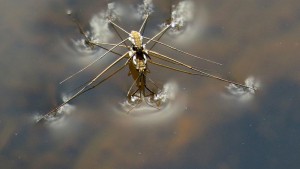Imagine staying dry underwater for months. The latest research from Northwestern University engineers identified a wide variety of surfaces that can do just that.
Through a combination of analysis of “air-retaining insect surfaces” used by aquatic insects, aging and degassing experiments on material surfaces, and molecular simulations, these engineers believe they understand what keeps certain surfaces dry underwater.
Saturation of air within “valleys” on surfaces (less than 1µm wide) deflects water, resulting in water droplets resting on the surface instead.
Whereas materials with this key surface roughness remained dry when submerged in ambient fluids, materials without this roughness did not.
The research team is the first to identify the ideal “roughness” needed in the texture of a surface to keep it dry for a long period of time when submerged in water.
The valleys in the surface roughness typically need to be less than one micron in width, the researchers found.
That’s really small, less than one millionth of a meter, but these nanoscopic valleys have macroscopic impact.
Understanding how the surfaces deflect water so well means the valuable feature could be reproduced in other materials on a mass scale, potentially saving billions of dollars in a variety of industries, from antifouling surfaces for shipping to pipe coatings resulting in lower drag.
The trick is to use rough surfaces of the right chemistry and size to promote vapor formation, which we can use to our advantage.
When the valleys are less than one micron wide, pockets of water vapor or gas accumulate in them by underwater evaporation or effervescence, just like a drop of water evaporates without having to boil it. These gas pockets deflect water, keeping the surface dry.
In their experiments, the researchers used a variety of materials with and without the key surface roughness and submerged them in water.
Samples with the nanoscale roughness remained dry for up to four months, the duration of the experiment.
Other samples were placed in harsh environments, where dissolved gas was removed from the ambient liquid, and they also remained dry.
The water-solid interfaces were imaged using scanning electron microscopy.
The degassing experiments also demonstrated that the air within the pores was due to vapor pressure of the ambient fluid rather than liquid condensation.
However, in most cases, this air dissolves from the pores back into the ambient liquid and the surface becomes capable of becoming wet.
The Northwestern researchers determined that the width of the pores can be optimized to retain the saturated air, which would keep the surface dry.
The researchers calculated the ideal conditions for a material to remain dry based on the pore diameter, pressure of gas within the pore, liquid pressure, liquid-gas surface energy, and the equilibrium contact angle the liquid would have on a flat surface of that material.
They believe that this nanoscale roughness is the key to retaining the vapor phase equilibrium that allows for the saturation of air within the pores of these surfaces.
The researchers also report that nature uses the same strategy of surface roughness in certain aquatic insects, such as water bugs and water striders.
Small hairs on the surfaces of their body have the less-than-one-micron spacing, allowing gas to be retained between the hairs.
These gas-retaining insects have surface properties consistent with our predictions, allowing them to stay dry for a long time.
These findings may have significant implications for many industries that work with aerodynamics and fluid drag, and may possibly be used to reduce the energy expenditure or increase efficiency in these industries.
For more information please visit: www.discover.northwestern.edu

